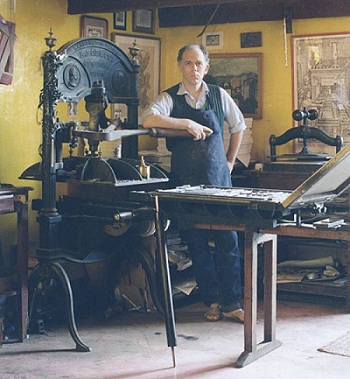Did You Know…?
One of the oldest printing presses still in operation anywhere in the world is in Tacámbaro, Michoacán.
Juan Pascoe lives on a remote ex-hacienda outside Tacámbaro, Michoacán. Visitors invited to view his work often think they’ve lost their way in the surrounding sugar-cane fields, but then suddenly catch their first glimpse of the former Great House, now his home, studio and workshop.

Photo reproduced by kind permission of Juan Pascoe
Juan Pascoe is a master printer. He is the foremost advocate in Mexico of continuing the centuries-old tradition of hand printing, using a hand press. His work is a rare combination of art, literature and science. Each piece of type is hand set. Each page of each book is lovingly assembled and then laboriously hand printed on a R. Hoe Washington handpress that dates back to 1838. This is definitely an avocation where patience is a virtue. Producing even 100 copies of a single short book of poetry may require Juan Pascoe’s full attention for several months. By comparison, computer-based typography and printing are altogether too rapid, and too mechanized, to allow the printer true control over his work or to allow him to form a genuine artistic rapport with his creation.
There are very few hand presses still in operation anywhere in the world. Even more sadly, virtually no-one today is investing the time required to learn the skills to continue their operation in the future.
Juan Pascoe was born in Chicago and moved to Mexico as a child. His father (a United Nations functionary and intermediate technology expert) is Mexican, his mother American. After taking American and English literature at Whitman College (in Walla Walla, Washington), he studied under Harry Duncan at The Cummington Press at the University of Iowa. Duncan, who died in 1997, began the Cummington Press in 1939 at the Cummington School of the Arts in Massachusetts and later moved the Press first to Iowa and then to the University of Nebraska.

Pascoe’s interest in handpresses led him to acquire (in Toluca) a R. Hoe Washington, Imperial No. 1 Iron Handpress, dating from 1838. He first began using the press in 1972 and founded the “Martín Pescador” (Kingfisher) imprint in Mexico City in 1976. He helped pay his business and living expenses during his first years as a printer by founding, playing the violin in (and traveling with) a band, El Mono Blanco, specialising in Veracruz jarocho music. In 1981, he moved the press to its current location, the former sugar-cane hacienda near Tacámbaro.
Among the three hundred or so works (almost all in Spanish) magnificently printed by Pascoe are:
La obra de Enrico Martínez [ The work of Enrico Martínez] by Juan Pascoe. 119 pages (42 x 31 centimeters) with 151 linecuts. 1996. Pascoe’s printing of “The Works of Enrico Martínez, Cosmographer of the King, Interpreter for the Holy Office of the Inquisition, Cutter and Founder of Typefaces, Engraver, Printer of Books, Author, Architect and Chief Overseer of the Work to Drain the Valley of Mexico” contains examples and samples of Martinez’ work, from the 1600s. Portions of the work are now being translated into English for the first time by a student-faculty research team from Whitman College, Walla Walla, Washington. Pascoe was in the Whitman class of 1969.

kind permission of Juan Pascoe
Los signos del zodiaco [ The Signs of the Zodiac] by Francisco Hernández. Thirty pages, with 14 linecuts of linocuts by Artemio Rodríguez. 1997. Artemio Rodríguez, the illustrator, was born in Tacámbaro in 1972. After moving to Mexico City to study agriculture, poetry and art, he returned to Tacámbaro in the early 1990s, to begin an apprenticeship with Pascoe. During that time, he began to make linocut illustrations for books and magazines. Rodríguez moved to the U.S. in 1994 and has lived in the Bay area since 1996. He has held numerous acclaimed exhibits in Mexico and the U.S.
Vivir para contarla [ Living to Tell the Tale] by Gabriel García Márquez, illustrated by Jan Hendrix. 196 large folio pages, with eight large, unfolding silk screens. 2004. The work, the first volume of this world famous author’s autobiography, was a private printing for friends, financed by the family.
Facsímil de primer impreso conocido oaxaqueño, con comentarios. [ Facsimile of the Earliest Known Document Printed in Oaxaca, with comments] 152 pages, with 36 linecuts of typographic pages. 1999. This book includes a bibliography of fray Sebastián de Santander y Torres written by Pascoe, now an acknowledged expert in the printers of New Spain in the seventeenth century. As he said in a press interview a few years ago, the sixteenth century has been exhaustively studied by specialist historians, but there are still great gaps in our knowledge of the sevententh century.
Pascoe managed to prove that at least one printing press was operating in Oaxaca in 1685, demonstrating in the process that it is possible to determine (from the typeface and illustrations) whether or not an early document was printed in Mexico, something previously believed not to be possible.
To contact Juan Pascoe:
Anyone interested in learning more about Juan Pascoe’s work is best advised to contact him directly by writing to: Taller Martín Pescador, Apartado Postal 79, C.P. 61650 Tacámbaro, Michoacán, Mexico.
Text © Copyright 2006 by Tony Burton. All rights reserved.

